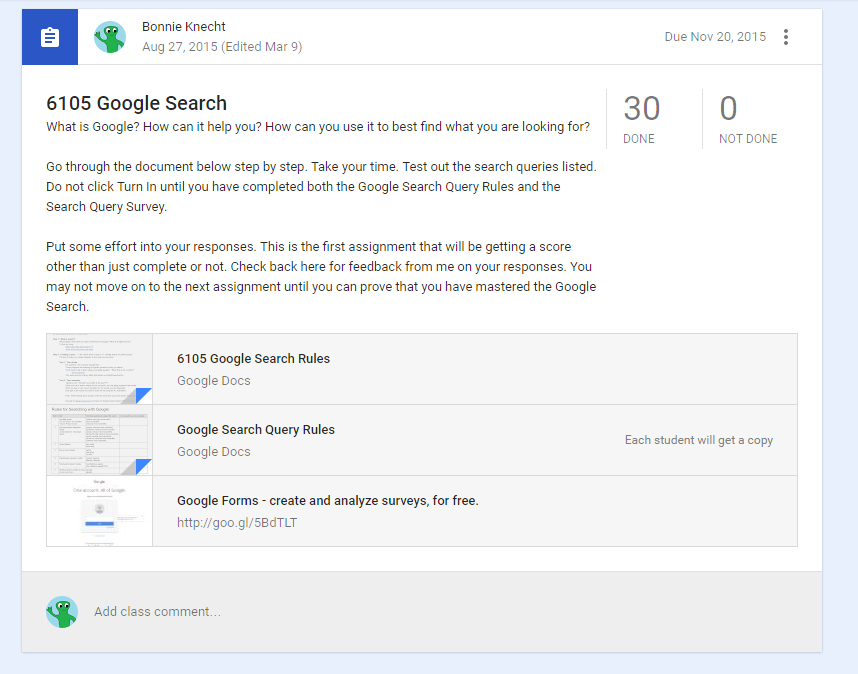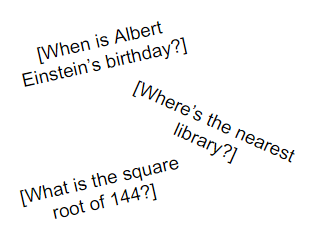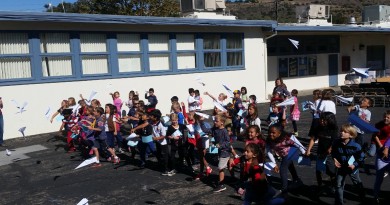Revising Assignments – Google Search Skills
One of my main tasks this summer is to revisit my science class curriculum. Overall, last year’s blended learning structure worked well so my task is to continue to refine and improve the activities. My hope is to be able to slightly “coast” this year rather than reinventing the wheel as I have done at least three times since starting to teach science. In looking back over my assignments, the assignments at the start of the year were definitely rougher than when I ended the year and show the amount that I learned about structuring blended learning assignments for my students.
One assignment I decided needed to be revisited was my assignment on Google Search Rules. My objective with this assignment was to start the year off by explicitly teaching the skills that students would need to find information throughout the course of the year. Previously, I taught this through direct instruction and discussion, but this invariably led to students going off track and searching for their own interests rather than creeping along through my examples with the rest of the class. Last year, the Google search assignment was the 5th assignment of the school year and students were still figuring out how to use Google Classroom and their Chromebooks and were adapting to my classroom structure.
Here was the initial post for the assignment:

Since posting this almost a year ago, I’ve learned quite a few things about creating manageable blended learning assignments. Here’s a breakdown of things I’ve learned since then:
First, the structure of the post. By about mid-October, I started streamlining my posts to only include the most important details: brief instructions, days to work on the assignment, supplies needed, and who you can work with. See my post on Google Classroom for more information. This post is much too rambling and has lots of do’s and don’ts that ended up being more confusing or ignored by the students. This sort of additional encouragement and information should be included in the attached assignment instruction page to start training students to open the document to learn more.
Second, the attachments. This assignment has three attachments: An instruction page, a document that will be copied for all students, and a survey. While this collection of documents makes complete sense for me as the teacher, in practice this was much too confusing for the students. To begin with, Google Classroom only displays the documents that are shared with all students in their Classroom feed. In order to see the assignment that had been copied for the students, they had to click the Open button and scroll down to a different section that contained the editable document. Many students only saw the form, didn’t really understand the form, and then submitted the assignment without accessing or completing both parts. Also, the attachments all have different naming patterns so it can be unclear when looking back what documents went with this assignment. I now start the name of all attached documents with the assignment number (i.e. 6105) so that there is no confusion what assignment the files connect to.
Third, the complexity. For this assignment, I expected students to fill out a document and complete a survey. Having two activities to support a topic seems like a reasonable amount of reinforcement, but the quality of the activities is much more important than the quantity. Do I really need the students to do both a document AND a survey or could they demonstrate understanding by only completing one? The activities on the survey are supposed to build off of the lessons on the document, but what happens if a students completes these in the wrong order? Why do I need to use the two different formats? Is there a different format that could cover the goals of both activities (or even the instruction sheet as well)?
Fourth, the feedback. Because I wanted students to do both a document and a survey, I needed to grade and provide feedback on both the document and the survey. The survey data goes into a spreadsheet so I had to decide if I wanted to use Autocrat to return and share the student responses with the student or if I would just give them a general “good job” on their answers that they’d never see again. The documents were all collected into one folder and could be looked through quickly using the Preview mode in Google Drive. However, if a student had trouble with some part, should I leave a comment on the document or just give them a general comment in Google Classroom? How do I show the grade for the survey vs the document?
Fifth, the learning. My observations throughout the course of the year and on the start of the year assessment showed me that the students did not absorb the information in this assignment. Their search practices were not changed by this assignment. When asked to share some tips for searching, most had no idea what that question was even asking and the majority of the others only knew the first one listed on the document (use key words). This assignment was not a success and I will attribute that to the delivery of the material rather than the complexity of the content.
From my experience from this and other assignments, I have learned to only ask students to complete one type of activity for an assignment. It can be a survey, a presentation, a document, or a physical activity, but having more than one component of an assignment will increase the likelihood that a component will be skipped or that my time in class will be spent explaining the directions rather than helping with the content. Every additional click is one more place that a distracted student can get off track and lose focus. In the few instances where I determined that I couldn’t reduce the components (for example: build a mountain out of clay and then analyze the mountain), I added an additional column to the gradebook with the same assignment number and gave students separate scores on the two parts. I could also have even made two separate Classroom posts about the assignment to physically keep the activities separate, although additional instructions about which part must be completed first would need to be included. Over the course of the year, my assignment posts became much more streamlined with the attachments. At most I would have an instruction document and an activity link, and I tried to incorporate the instructions into the activity as much as possible to require only one link for students.
I’ve also learned that grading an assignment should not feel like a waste of my time. This is my opportunity to get to know my students and to provide them meaningful feedback. If accessing their work and providing comments is too convoluted or becomes something I keep avoiding, then the assignment is getting in the way of me doing my job. I have several assignments from the beginning of the year that were very time consuming to grade, but the time I spent grading them was not equivalent to the amount of value or learning that the students got out of the assignment. Because of this, I’ve had to consider my workflow for grading an assignment when I create an activity so that I can quickly and clearly address any problems and recognize the students who have demonstrated mastery.
This assignment needed a logistical overhaul. Taking all my experiences into consideration, I decided to instead redo this assignment as a Slides presentation. I like Slides because it is easier to include step by step instructions and to direct focus to one small part of an assignment, rather than processing the entire content on a document. This presentation now incorporates the instruction document, the task from the shared document, and some of the more meaningful questions on the survey. To help clarify what students need to do, I’m sticking with a standard format of putting student action tasks inside orange text boxes. When grading this, all that I will need to do is scroll through the presentation and make sure that the information in the orange boxes has been completed. If there’s a problem, I can put a comment on the specific slide to be fixed, and the icon next to the slide previews shows the students where to quickly go back to.
We’ll see in September if this new method of content delivery is more accessible and if student searching practices change after this assignment.
Original Assignments
6105 Google Search Rules – Instruction document
Google Search Query Rules – Copy made for each student
What makes a good search query? – Survey
Updated Assignment
6105 Google Search Skills – Presentation will be copied for each student

